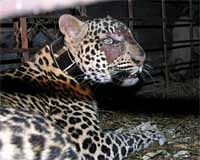

"Hand-raised for almost past one year like a baby, the two male cubs were last week radio-collared in anticipation of their forever return to the wild," says their caretaker Bhaskar Choudhury. This is the first known instance of clouded leopards being rehabilitated and radio-collared in India.
There have been only four cases of collaring of the clouded leopard. The recent one was in 2008 when Andrew Hearn and Joanna Ross, researchers studying Borneo's wild cats in Sabah, Malaysia, had captured and radio collared a clouded leopard in the Borneo's Danum Valley to learn crucial information about the animal's range and activity patterns. "The cubs have undergone eight months of acclimatisation in the wild. Initially, they were taken for walks during the day, while being kept in a spacious enclosure at night for safety.
In the past two months, the cubs were allowed to be in the wild 24/7. As the cubs are now free-ranging and no longer dependent on the enclosure, it was prudent to radio-collar them for monitoring as we will receive signal about their movement through the gadget," says NVK Ashraf, Wildlife Rescue Director with Wildlife Trust of India, an NGO.
The cubs, both males, were confiscated from a villager in March last year by a team of Assam Forest Department staff. Less than a month old at the time of rescue, they were handed over to the IFAW-WTI Mobile Veterinary Services (MVS) for hand-raising supported by Bodoland Territorial Council.
However, the attempt to release in wild is fraught with several challenges. This arboreal shy creature is facing threat of habitat loss due to widespread deforestation and hunting for use in Chinese medicinal preparations and radio-collaring aims to ensure to prevent such threats at the initial stage.
"We are eagerly waiting for the result. The clouded leopard is seen in limited numbers in these forests and this effort will contribute in the conservation of this rare animal," says GC Basumatary, Council Head, Forest Department, BTC. "We are using expandable collars and they are expected to remain for a year, if not longer. They will stretch and fall off due to normal wear and tear," says Dr Ian Robinson, IFAW's Emergency Relief Director.
Faced with poaching and habitat threats, population of Clouded leopards is on the decline. Enlisted as "vulnerable to extinction" as a mere 10,000 of them are now left in the wild of the Northeast of the country, besides Sumatra, Borneo and Java, Nepal, Myanmar and southern China. Though they are called clouded leopards, they are not leopards and are closely related to tigers, according to experts.